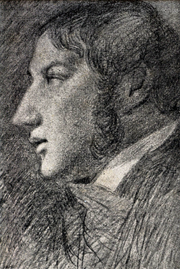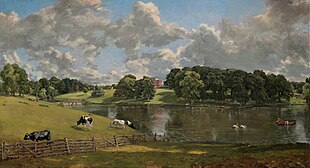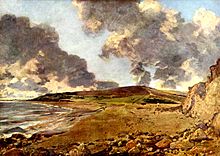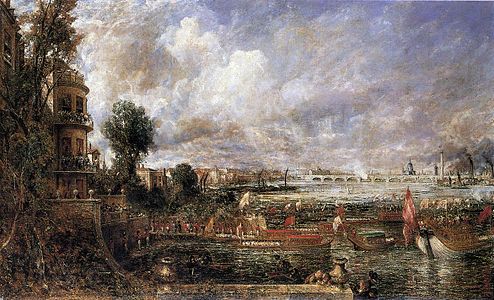Quick Facts

Biography
John Constable, RA (; 11 June 1776 – 31 March 1837) was an English Romantic painter. Born in Suffolk, he is known principally for his landscape paintings of Dedham Vale, the area surrounding his home — now known as "Constable Country" — which he invested with an intensity of affection. "I should paint my own places best", he wrote to his friend John Fisher in 1821, "painting is but another word for feeling".
His most famous paintings include Wivenhoe Park of 1816,Dedham Vale of 1802 and The Hay Wain of 1821. Although his paintings are now among the most popular and valuable in British art, Constable was never financially successful. He did not become a member of the establishment until he was elected to the Royal Academy at the age of 52. His work was embraced in France, where he sold more works than in his native England and inspired the Barbizon school.
Early career

John Constable was born in East Bergholt, a village on the River Stour in Suffolk, to Golding and Ann (Watts) Constable. His father was a wealthy corn merchant, owner of Flatford Mill in East Bergholt and, later, Dedham Mill in Essex. Golding Constable owned a small ship, The Telegraph, which he moored at Mistley on the Stour estuary, and used to transport corn to London. He was a cousin of the London tea merchant, Abram Newman. Although Constable was his parents' second son, his older brother was intellectually disabled and John was expected to succeed his father in the business. After a brief period at a boarding school in Lavenham, he was enrolled in a day school in Dedham. Constable worked in the corn business after leaving school, but his younger brother Abram eventually took over the running of the mills.
In his youth, Constable embarked on amateur sketching trips in the surrounding Suffolk and Essex countryside, which was to become the subject of a large proportion of his art. These scenes, in his own words, "made me a painter, and I am grateful"; "the sound of water escaping from mill dams etc., willows, old rotten planks, slimy posts, and brickwork, I love such things." He was introduced to George Beaumont, a collector, who showed him his prized Hagar and the Angel by Claude Lorrain, which inspired Constable. Later, while visiting relatives in Middlesex, he was introduced to the professional artist John Thomas Smith, who advised him on painting but also urged him to remain in his father's business rather than take up art professionally.

In 1799, Constable persuaded his father to let him pursue a career in art, and Golding granted him a small allowance. Entering the Royal Academy Schools as a probationer, he attended life classes and anatomical dissections, and studied and copied old masters. Among works that particularly inspired him during this period were paintings by Thomas Gainsborough, Claude Lorrain, Peter Paul Rubens, Annibale Carracci and Jacob van Ruisdael. He also read widely among poetry and sermons, and later proved a notably articulate artist.
In 1802 he refused the position of drawing master at Great Marlow Military College, a move which Benjamin West (then master of the RA) counselled would mean the end of his career. In that year, Constable wrote a letter to John Dunthorne in which he spelled out his determination to become a professional landscape painter:
His early style has many qualities associated with his mature work, including a freshness of light, colour and touch, and reveals the compositional influence of the old masters he had studied, notably of Claude Lorrain. Constable's usual subjects, scenes of ordinary daily life, were unfashionable in an age that looked for more romantic visions of wild landscapes and ruins. He made occasional trips further afield.

By 1803, he was exhibiting paintings at the Royal Academy. In April he spent almost a month aboard the East Indiaman Coutts as it visited south-east ports while sailing from London to Deal before leaving for China.
In 1806 Constable undertook a two-month tour of the Lake District. He told his friend and biographer, Charles Leslie, that the solitude of the mountains oppressed his spirits, and Leslie wrote:
To make ends meet, Constable took up portraiture, which he found dull, though he executed many fine portraits. He also painted occasional religious pictures but, according to John Walker, "Constable's incapacity as a religious painter cannot be overstated."
Constable adopted a routine of spending winter in London and painting at East Bergholt in summer. In 1811 he first visited John Fisher and his family in Salisbury, a city whose cathedral and surrounding landscape were to inspire some of his greatest paintings.
Marriage and later life

From 1809, his childhood friendship with Maria Elizabeth Bicknell developed into a deep, mutual love. Their marriage in 1816 when Constable was 40 was opposed by Maria's grandfather, Dr Rhudde, rector of East Bergholt. He considered the Constables his social inferiors and threatened Maria with disinheritance. Maria's father, Charles Bicknell, solicitor to King George IV and the Admiralty, was reluctant to see Maria throw away her inheritance. Maria pointed out to John that a penniless marriage would detract from any chances he had of making a career in painting. Golding and Ann Constable, while approving the match, held out no prospect of supporting the marriage until Constable was financially secure. After they died in quick succession, Constable inherited a fifth share in the family business.

John and Maria's marriage in October 1816 at St Martin-in-the-Fields (with Fisher officiating) was followed by time at Fisher's vicarage and a honeymoon tour of the south coast. The sea at Weymouth and Brighton stimulated Constable to develop new techniques of brilliant colour and vivacious brushwork. At the same time, a greater emotional range began to be expressed in his art.
Although he had scraped an income from painting, it was not until 1819 that Constable sold his first important canvas, The White Horse, which led to a series of "six footers", as he called his large-scale paintings. That year he was elected an Associate of the Royal Academy. In 1821 he showed The Hay Wain (a view from Flatford Mill) at the Academy's exhibition. Théodore Géricault saw it on a visit to London and praised Constable in Paris, where a dealer, John Arrowsmith, bought four paintings, including The Hay Wain. It was exhibited at the Paris Salon of 1824, winning a gold medal.
Of Constable's colour, Delacroix wrote in his journal: "What he says here about the green of his meadows can be applied to every tone". Delacroix repainted the background of his 1824 Massacre de Scio after seeing the Constables at Arrowsmith's Gallery, which he said had done him a great deal of good.
In his lifetime, Constable sold only 20 paintings in England, but in France he sold more than 20 in just a few years. Despite this, he refused all invitations to travel internationally to promote his work, writing to Francis Darby: "I would rather be a poor man [in England] than a rich man abroad." In 1825, perhaps due partly to the worry of his wife's ill-health, the uncongeniality of living in Brighton ("Piccadilly by the Seaside"), and the pressure of numerous outstanding commissions, he quarrelled with Arrowsmith and lost his French outlet.
After the birth of their seventh child in January 1828, Maria fell ill and died of tuberculosis on 23 November at the age of 41. Intensely saddened, Constable wrote to his brother Golding, "hourly do I feel the loss of my departed Angel—God only knows how my children will be brought up...the face of the World is totally changed to me".
Thereafter, he dressed in black and was, according to Leslie, "a prey to melancholy and anxious thoughts". He cared for his seven children alone for the rest of his life. The children were John Charles, Maria Louisa, Charles Golding, Isobel, Emma, Alfred, and Lionel. Only Charles Golding Constable produced offspring, a son.

Shortly before Maria died, her father had also died, leaving her £20,000. Constable speculated disastrously with the money, paying for the engraving of several mezzotints of some of his landscapes in preparation for a publication. He was hesitant and indecisive, nearly fell out with his engraver, and when the folios were published, could not interest enough subscribers. Constable collaborated closely with the talented mezzotinter David Lucas on 40 prints after his landscapes, one of which went through 13 proof stages, corrected by Constable in pencil and paint. Constable said, "Lucas showed me to the public without my faults", but the venture was not a financial success.
He was elected to the Royal Academy in February 1829, at the age of 52. In 1831 he was appointed Visitor at the Royal Academy, where he seems to have been popular with the students.
He began to deliver public lectures on the history of landscape painting, which were attended by distinguished audiences. In a series of lectures at the Royal Institution, Constable proposed a three-fold thesis: firstly, landscape painting is scientific as well as poetic; secondly, the imagination cannot alone produce art to bear comparison with reality; and thirdly, no great painter was ever self-taught.
He also spoke against the new Gothic Revival movement, which he considered mere "imitation".
In 1835, his last lecture to students of the Royal Academy, in which he praised Raphael and called the Academy the "cradle of British art", was "cheered most heartily". He died on the night of 31 March 1837, apparently from heart failure, and was buried with Maria in the graveyard of St John-at-Hampstead, Hampstead. (His children John Charles Constable and Charles Golding Constable are also buried in this family tomb.)


Art

Constable quietly rebelled against the artistic culture that taught artists to use their imagination to compose their pictures rather than nature itself. He told Leslie, "When I sit down to make a sketch from nature, the first thing I try to do is to forget that I have ever seen a picture".
Although Constable produced paintings throughout his life for the "finished" picture market of patrons and R.A. exhibitions, constant refreshment in the form of on-the-spot studies was essential to his working method. He was never satisfied with following a formula. "The world is wide", he wrote, "no two days are alike, nor even two hours; neither were there ever two leaves of a tree alike since the creation of all the world; and the genuine productions of art, like those of nature, are all distinct from each other."
Constable painted many full-scale preliminary sketches of his landscapes to test the composition in advance of finished pictures. These large sketches, with their free and vigorous brushwork, were revolutionary at the time, and they continue to interest artists, scholars and the general public. The oil sketches of The Leaping Horse and The Hay Wain, for example, convey a vigour and expressiveness missing from Constable's finished paintings of the same subjects. Possibly more than any other aspect of Constable's work, the oil sketches reveal him in retrospect to have been an avant-garde painter, one who demonstrated that landscape painting could be taken in a totally new direction.

Constable's watercolours were also remarkably free for their time: the almost mystical Stonehenge, 1835, with its double rainbow, is often considered to be one of the greatest watercolours ever painted. When he exhibited it in 1836, Constable appended a text to the title: "The mysterious monument of Stonehenge, standing remote on a bare and boundless heath, as much unconnected with the events of past ages as it is with the uses of the present, carries you back beyond all historical records into the obscurity of a totally unknown period."

In addition to the full-scale oil sketches, Constable completed numerous observational studies of landscapes and clouds, determined to become more scientific in his recording of atmospheric conditions. The power of his physical effects was sometimes apparent even in the full-scale paintings which he exhibited in London; The Chain Pier, 1827, for example, prompted a critic to write: "the atmosphere possesses a characteristic humidity about it, that almost imparts the wish for an umbrella".
The sketches themselves were the first ever done in oils directly from the subject in the open air. To convey the effects of light and movement, Constable used broken brushstrokes, often in small touches, which he scumbled over lighter passages, creating an impression of sparkling light enveloping the entire landscape. One of the most expressionistic and powerful of all his studies is Seascape Study with Rain Cloud, painted about 1824 at Brighton, which captures with slashing dark brushstrokes the immediacy of an exploding cumulus shower at sea. Constable also became interested in painting rainbow effects, for example in Salisbury Cathedral from the Meadows, 1831, and in Cottage at East Bergholt, 1833.
To the sky studies he added notes, often on the back of the sketches, of the prevailing weather conditions, direction of light, and time of day, believing that the sky was "the key note, the standard of scale, and the chief organ of sentiment" in a landscape painting. In this habit he is known to have been influenced by the pioneering work of the meteorologist Luke Howard on the classification of clouds; Constable's annotations of his own copy of Researches About Atmospheric Phaenomena by Thomas Forster show him to have been fully abreast of meteorological terminology. "I have done a good deal of skying", Constable wrote to Fisher on 23 October 1821; "I am determined to conquer all difficulties, and that most arduous one among the rest".
Constable once wrote in a letter to Leslie, "My limited and abstracted art is to be found under every hedge, and in every lane, and therefore nobody thinks it worth picking up". He could never have imagined how influential his honest techniques would turn out to be. Constable's art inspired not only contemporaries like Géricault and Delacroix, but the Barbizon School, and the French impressionists of the late nineteenth century.
Gallery

Boat-building near Flatford Mill, 1815. Victoria and Albert Museum, London

Salisbury Cathedral from the Bishop's Grounds c. 1825. As a gesture of appreciation for John Fisher, the Bishop of Salisbury, who commissioned this painting, Constable included the Bishop and his wife in the canvas. Their figures can be seen at the bottom left of the painting, behind the fence and under the shade of the trees. Frick Collection, New York

The Opening of Waterloo Bridge seen from Whitehall Stairs, 18 June 1817, oil on canvas, c. 1832. Tate Britain

The Hay Wain (1821) National Gallery, London
Selected paintings
See also Category:Paintings by John Constable for those with their own articles.
- Dedham Vale (1802) – Victoria and Albert Museum, London
- Landscape: Two Boys Fishing (1813) – Anglesey Abbey, Cambs, NT
- Landscape: Ploughing Scene in Suffolk (1814, revised c.1816 and 1831) – Yale Center for British Art, New Haven, CT
- The Stour Valley And Dedham Village (1814–1815) – Museum of Fine Arts, Boston
- Boat-building near Flatford Mill (1815) – Victoria and Albert Museum, London
- Golding Constable's Flower Garden (1815) – Ipswich Museum, Ipswich
- Golding Constable's Kitchen Garden (1815) – Ipswich Museum, Ipswich
- Portrait of Maria Bicknell, Mrs. John Constable (1816) – Tate Gallery, London
- Wivenhoe Park, Essex (1816) – National Gallery of Art, Washington, D.C.
- Flatford Mill (original title Scene on a Navigable River; 1816–17) – Tate Britain
- Weymouth Bay: Bowleaze Cove and Jordon Hill (1816–17) – National Gallery, London
- The White Horse (original title A Scene on the river Stour) (1819) – Frick Collection, New York City
- Hampstead Heath (1820) – Fitzwilliam Museum, Cambridge
- Stratford Mill (1820) – National Gallery, London
- The Hay Wain (original title Landscape: Noon; 1821) – National Gallery, London
- View on the Stour near Dedham (1822) – The Huntington Library, San Marino, CA
- Salisbury Cathedral from the Bishop's Grounds (1823) – Victoria and Albert Museum, London
- The Lock (1824) – Thyssen-Bornemisza Museum, Madrid
- Seascape Study with Rain Clouds (1824–25) – Royal Academy of Arts, London
- Brighton Beach (c.1824–26) – Dunedin Public Art Gallery, Dunedin
- The Leaping Horse (1825) – Royal Academy of Arts, London
- The Cornfield (1826) – National Gallery, London
- Dedham Vale (1828) – National Gallery of Scotland, Edinburgh
- Hadleigh Castle (1829) – Yale Center for British Art and sketch Tate Britain
- Salisbury Cathedral from the Meadows (1831) – Private collection; on loan to National Gallery, London
- The Opening of Waterloo Bridge seen from Whitehall Stairs, 18 June 1817 (c.1832) – Tate Britain, London
- The Valley Farm (1835) – Tate Gallery, London
- Arundel Mill and Castle (c.1836–37) – Toledo Museum of Art, Toledo, OH
Constable locations

Bridge Cottage is a National Trust property, open to the public. Nearby Flatford Mill and Willy Lott's Cottage (the house visible in The Hay Wain) are used by the Field Studies Council for courses. The largest collection of original Constable paintings outside London is on display at Christchurch Mansion in Ipswich.




